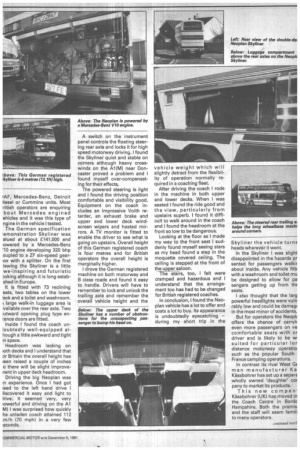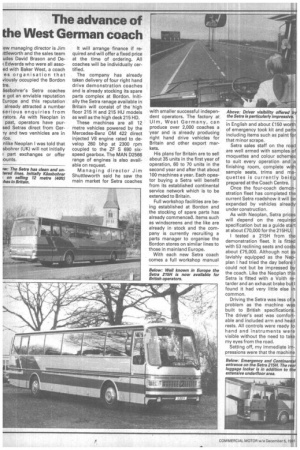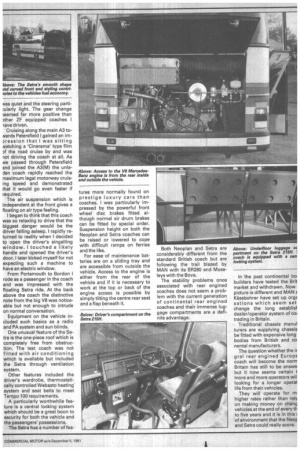The advance of the West German coach
Page 22

Page 23

Page 24

Page 25

If you've noticed an error in this article please click here to report it so we can fix it.
Neoplan and Setra, two well established West German coach manufacturers are launching their models in the UK. Noel Millier looks at what they have on offer
E BRITISH coach scene has dergone a dramatic transforEtion in recent months and it ems an ever increasing mber of imported coaches are -npeting for the changing new icle market.
"he names of Neoplan and Secould almost be the two most .pected in European coaching. eir intentions to compete for itish business have been )wn since the last Internale' Motor Show at Birmingn when both manufacturers right hand drive coaches for tish operators on display.
loth Neoplan and Setra are ;ed in West Germany and .h already have established i proven model ranges sold in ny world markets. I describe. m as coach manufacturers :ause their integral products complete vehicles in much same way as a family car and the combination of separa, built body and chassis so nmon in Britain.
the last few weeks both ,e announced their United gdom representation and UK del ranges and I visited them ind out what they are offering operators. From my visits I ned the impression that both ind to be here to stay but they establishing their presence ifferent ways.
My first visit was to Carlton Commercials which has recently been appointed sales agents for Neoplan in the UK. General manager Jack Miles told me of his company and of Neoplan's intentions for Britain. I also had the opportunity to take a German specification Neoplan Skyliner for a drive.
Carlton PSV Sales of Doncaster Road, Oldcotes, near Worksop, in Nottinghamshire, is already getting geared up to receive its first Neoplans for its British customers. A small section has been built for a supply of Neoplan spare parts which have already been ordered from the Stuttgart factory. The company will be able to supply any of the Neoplan range of products except the airport apron service buses and ambulance ranges. Jack Miles said he expects most demand to be for Jetliner, Cityliner and Skyliner vehicles as well as the front wheel drive Berlin built Neoplan minibus.
The three-axle high deck Neoplan Spaceliner he thought would be unsuitable and unlikely to meet British tilt requirements, but almost anything else is available for delivery by April next year, to customer specifications and to meet British certification requirements. Briefly the Jetliner is a normal height luxury coach available in 7.5, 9.3, 10.1, 11 or 12 metre versions. As a guide Jetliner prices start at about £67,000. The Cityliner is available in 12 metre form and is a high floor 3.5 mm high coach with a large amount of underfloor luggage capacity.
London operator Blueways already has a Neoplan Cityliner in operation. Cityliner prices star at about £72,000.
The Neoplan Skyliner threE axle double decker prices start al about £120,000 and TrathenE Coaches of Plymouth has twc Skyliners in service betweer London and Plymouth and a further three units on order. The 12 metre deckers weigh about 22 tons on three axles and are being operated on a special dispensation issued by the Department of Transport. Carlton has already received a number of firm orders for both Cityliner and Skyliner models.
The Berlin built front wheel drive minibus powered by either a naturally aspirated or turbocharged five cylinder Mercedes-Benz engine is available with up to 22 passenger seats. Prices for this 6.450m vehicle range from £25,000.
Neoplan offer 25 different engine options throughout its full size coach range including MAN,
1AF, Mercedes-Benz, Detroit Piesel or Cummins units. Most ,ritish operators are enquiring bout Mercedes engined ehicles and it was this type of ngine in the vehicle I tested.
The German specification emonstration Skyliner was alued at about £141,000 and ,owered by a Mercedes-Benz '10 engine developing 320 bhp oupled to a ZF six-speed gearlox with a splitter. On the first iewing the Skyliner is a little we-inspiring and futuristic Doki ng although it is long estabshed in Europe.
It is fitted with 73 reclining eats, two tables on the lower leck and a toilet and washroom. 1/4 large walk-in luggage area is vailable over the rear axle. Two lutward opening plug type enrance doors are fitted.
Inside I found the coach unloubtedly well-equipped alhough a little awkward and tight in space.
Headroom was lacking on loth decks and I understand that or Britain the overall height has peen raised a couple of inches o there will be slight improvenent in upper deck headroom. Driving the big Neoplan was in experience. Once I had got ised to the left hand drive I liscovered it easy and light to !rive. It seemed very, very powerful and driving on the Al M) I was surprised how quickly he unladen coach attained 112 .m/h (70 mph) in a very few ,econds. A switch on the instrument panel controls the floating steering rear axle and locks it for high speed motorway driving. I found the Skyliner quiet and stable on corners although heavy crosswinds on the Al(M) near Doncaster proved a problem and I found myself over-compensating for their effects.
The powered steering is light and I found the driving position comfortable and visibility good. Equipment on the coach includes an impressive Voith retarder, an exhaust brake and upper and lower deck windscreen wipers and heated mirrors. A TV monitor is fitted to enable the driver to see what is going on upstairs. Overall height of this German registered coach is four metres and for British operators the overall height is marginally higher.
I drove the German registered machine on both motorway and B class roads and found it easy to handle. Drivers will have to remember to lock and unlock the trailing axle and remember the overall vehicle height and the vehicle weight which will slightly detract from the flexibility of operation normally required in a coaching fleet.
After driving the coach I rode in the machine in both upper and lower decks. When I was seated I found the ride good and the view, particularly from upstairs superb. I found it difficult to walk around in the coach and I found the headroom at the front so low to be dangerous.
Looking at the floor as I made my way to the front seat I suddenly found myself seeing stars as my head found a step in the moquette covered ceiling. The ceiling is stepped at the front of the upper saloon.
The stairs, too, I felt were cramped and hazardous and I understand that the arrangement too has had to be changed for British registered coaches.
In conclusion, I found the Neoplan vehicle has a lot to offer and costs a lot to buy. Its appearance is undoubtedly eyecatching — during my short trip in the Skyliner the vehicle turnE heads wherever it went.
In the Skyliner I was slight disappointed in the hazards pr sented for passengers walkir about inside. Any vehicle Mt( with a washroom and toilet mu be designed to allow for pa sengers getting up from thE seats.
I also thought that the larg powerful headlights were vuln rably low and could be damagr in the most minor of accidents.
But for operators the Neoplr offers the chance of carryir even more passengers on ye comfortable seats with or driver and is likely to be wi suited for particular lor distance motorway operatioi such as the popular South France camping operations.
In contrast its rival West GE man manufacturer Ka Kassbohrer has set up a separe wholly owned 'daughter' cot pany to market its products.
This new compan. K6ssbohrer (UK) has moved in the Coach Centre in Bordc Hampshire. Both the premis and the staff will seem famili to many operators.
ew managing director is Jim ittleworth and the sales team udes David Brason and Dec Edwards who were all assoed with Baker West, a coach es organisation that viously occupied the Borden tre.
assbohrer's Setra coaches e got an enviable reputation Europe and this reputation already attracted a number serious enquiries from rators. As with Neoplan in past, operators have pursed Setras direct from Geriy and two venhicles are in rice.
nlike Neoplan I was told that sbohrer (UK) will not initially part exchanges or offer iounts. It will arrange finance if required and will offer a fixed price at the time of ordering. All coaches will be individually certified.
The company has already taken delivery of four right hand drive demonstration coaches and is already stocking its spare parts complex at Borden. Initially the Setra renege available in Britain will consist of the high floor 215 H and 215 HU models as well as the high deck 215 HD.
These machines are all 12 metre vehicles powered by the Mercedes-Benz OM 422 direct injected V8 engine rated to develop 280 bhp at 2300 rpm coupled to the ZF S 690 sixspeed gearbox. The MAN D2566 range of engines is also available on request.
Managing director Jim Shuttleworth said he saw the main market for Setra coaches with smaller successful independent operators. The factory at Ulm, West Germany, can produce over 2,000 coaches a year and is already producing right hand drive vehicles for Britain and other export markets.
His plans for Britain are to sell about 35 units in the first year of operation, 60 to 70 units in the second year and after that about 100 machines a year. Each opeator buying a Setra will benefit from its established continental service network which is to be extended to Britain.
Full workshop facilities are being established at Borden and the stocking of spare parts has already commenced. Items such as windscreens and the like are already in stock and the company is currently recruiting a parts manager to organise the Bordon stores on similar lines to those in mainland Europe.
With each new Setra coach comes a full workshop manual in English and about £150 worth of emergency took kit and parts including items such as paint for that minor scrape.
Setra sales staff on the road are well armed with samples of moquettes and colour schemes to suit every operation and a finishing room, complete with sample seats, trims and moquettes is currently being prepared at the Coach Centre.
Once the four-coach demonstration fleet has completed the current Setra roadshow it will be expanded by vehicles already under construction.
As with Neoplan, Setra prices will depend on the required specification but as a guide start at about £70,000 for the 215HU.
I tested a 215H from the demonstration fleet. It is fitted with 53 reclining seats and costs about £75,000. Although not as lavishly equipped as the Neoplan I had tried the day before could not but be impressed by the coach. Like the Neoplan this Setra is fitted with a Voith retarder and an exhaust brake but I found it had very little else in common.
Driving the Setra was less of a problem as the machine was built to British specifications. The driver's seat was comfort. able and included arm and head rests. All controls were ready to hand and instruments were visible without the need to take my eyes from the road.
Setting off, my immediate impressions were that the machine was quiet and the steering parti;ularly light. The gear change ;eemed far more positive than )ther ZF equipped coaches I lave driven.
Cruising along the main A3 to'yards Petersfield I.gained an im)ression that I was sitting Natching a 'Cinerama' type film af the road cruise by and was lot driving the coach at all. As Ne passed through Petersfield and joined the A3(M) the unladen coach rapidly reached the maximum legal motorway cruising speed and demonstrated that it would go even faster if required.
The air suspension which is independent at the front gives a floating on air type feeling.
I began to think that this coach was so relaxing to drive that the biggest danger would be the driver falling asleep. I rapidly returned to reality when I decided to open the driver's singalling window. I touched a likely handle and opened the driver's door. I later kicked myself for not expecting such a machine to have an electric window.
From Portsmouth to Bordon I rode as a passenger in the coach and was impressed with the floating Setra ride. At the back above the coach the distinctive note from the big V8 was noticeable but not enough to intrude on normal conversation.
Equipment on the vehicle included such basics as a radio and PA system and sun blinds.
One unusual feature of the Setra is the one-piece roof which is completely free from obstruction. The test coach was not fitted with air conditioning which is available but included the Setra through ventilation system.
Other features included the driver's wardrobe, thermostatically controlled Webasto heating' system and seat belts to meet Tempo 100 requirements.
A particularly worthwhile feature is a central locking system which should be a great boon to security for both the vehicle and the passengers' possessions.
The Setra has a number of fea lures more normally found on prestige luxury cars than coaches. I was particularly impressed by the powerful front wheel disc brakes fitted although normal air drum brakes can be fitted by special order. Suspension height on both the Neoplan and Setra coaches can be raised or lowered to cope with difficult ramps on ferries and the like.
For ease of maintenance batteries are on a sliding tray and are accessible from outside the vehicle. Access to the engine is either from the rear of the vehicle and if it is necessary to work at the top or back of the engine access is possible by simply tilting the centre rear seat and a flap beneath it. Both Neoplan and Setra are considerably different from the standard British coach but are following the trail blazed by MAN with its SR280 and Moseleys with the Bova.
The stability problems once associated with rear engined coaches does not seem a problem with the current generation of continental rear engined coaches and their immense luggage compartments are a definite advantage.
In the past continental bo, builders have tested the Brit market and withdrawn. Now• picture is different and MAN E 1(ssbohrer have set up orgE sations which seem set change the long establisf dealer/operator system of cm trading in Britain.
Traditional chassis manui turers are supplying chassis be fitted with expensive long bodies from British and co nental manufacturers.
The question whether the ir gral rear engined EuropE coach will become the norrr Britain has still to be answe but it now seems certain t more and more operators wil looking for a longer operat life from their vehicles.
They will operate for mi higher rates rather than rely on making money on chang vehicles at the end of every th to five years and it is in this of environment that the NEN4 and Setra could really score.


































































